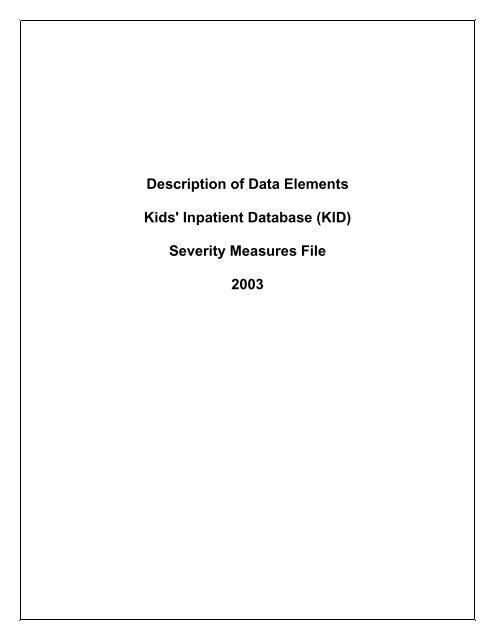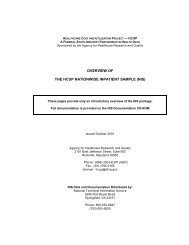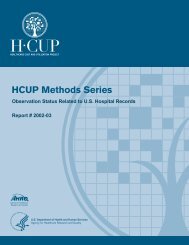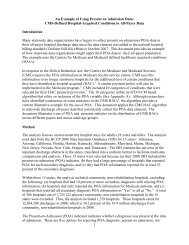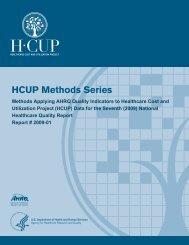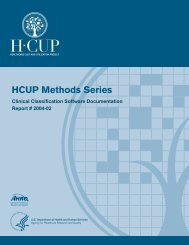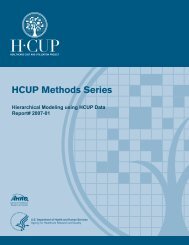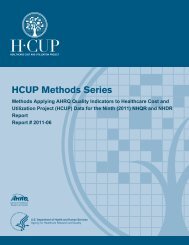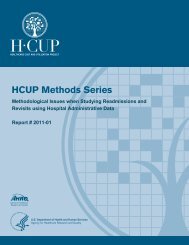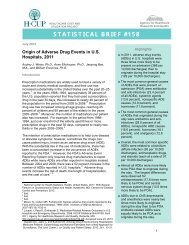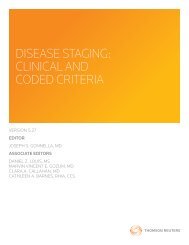Severity - HCUP
Severity - HCUP
Severity - HCUP
Create successful ePaper yourself
Turn your PDF publications into a flip-book with our unique Google optimized e-Paper software.
Description of Data Elements<br />
Kids' Inpatient Database (KID)<br />
<strong>Severity</strong> Measures File<br />
2003
Table of Contents<br />
APRDRG - All Patient Refined DRG ............................................................................... 1<br />
APRDRG_Risk_Mortality - All Patient Refined DRG: Risk of Mortality Subclass ............ 2<br />
APRDRG_<strong>Severity</strong> - All Patient Refined DRG: <strong>Severity</strong> of Illness Subclass ................... 3<br />
APSDRG - All-Payer <strong>Severity</strong>-adjusted DRG.................................................................. 4<br />
APSDRG_LOS_Weight - All-Payer <strong>Severity</strong>-adjusted DRG: Length of Stay Weight ...... 5<br />
APSDRG_Charge_Weight - All-Payer <strong>Severity</strong>-adjusted DRG: Charge Weight ............. 6<br />
APSDRG_Mortality_Weight – All-Payer <strong>Severity</strong>-adjusted DRG: Mortality Weight........ 7<br />
CM_AIDS - AHRQ comorbidity measure: acquired immune deficiency syndrome.......... 8<br />
CM_ALCOHOL - AHRQ comorbidity measure: alcohol abuse........................................ 9<br />
CM_ANEMDEF - AHRQ comorbidity measure: deficiency anemias ............................. 10<br />
CM_ARTH - AHRQ comorbidity measure: rheumatoid arthritis/collagen vascular<br />
diseases ........................................................................................................................ 11<br />
CM_BLDLOSS - AHRQ comorbidity measure: chronic blood loss anemia ................... 12<br />
CM_CHF - AHRQ comorbidity measure: congestive heart failure................................. 13<br />
CM_CHRNLUNG - AHRQ comorbidity measure: chronic pulmonary disease .............. 14<br />
CM_COAG - AHRQ comorbidity measure: coagulopathy ............................................. 15<br />
CM_DEPRESS - AHRQ comorbidity measure: depression .......................................... 16<br />
CM_DM - AHRQ comorbidity measure: diabetes, uncomplicated................................. 17<br />
CM_DMCX - AHRQ comorbidity measure: diabetes with chronic complications .......... 18<br />
CM_DRUG - AHRQ comorbidity measure: drug abuse................................................. 19<br />
CM_HTN_C - AHRQ comorbidity measure: hypertension (combine uncomplicated and<br />
complicated).................................................................................................................. 20<br />
CM_HYPOTHY - AHRQ comorbidity measure: hypothyroidism.................................... 21<br />
CM_LIVER - AHRQ comorbidity measure: liver disease............................................... 22<br />
CM_LYMPH - AHRQ comorbidity measure: lymphoma ................................................ 23<br />
CM_LYTES - AHRQ comorbidity measure: fluid and electrolyte disorders ................... 24<br />
CM_METS - AHRQ comorbidity measure: metastatic cancer ....................................... 25<br />
CM_NEURO - AHRQ comorbidity measure: other neurological disorders.................... 26<br />
CM_OBESE - AHRQ comorbidity measure: obesity ..................................................... 27<br />
CM_PARA - AHRQ comorbidity measure: paralysis ..................................................... 28<br />
CM_PERIVASC - AHRQ comorbidity measure: peripheral vascular disorders ............. 29<br />
CM_PSYCH - AHRQ comorbidity measure: psychoses................................................ 30<br />
CM_PULMCIRC - AHRQ comorbidity measure: pulmonary circulation disorders......... 31<br />
CM_RENLFAIL - AHRQ comorbidity measure: renal failure ......................................... 32<br />
CM_TUMOR - AHRQ comorbidity measure: solid tumor without metastasis ................ 33<br />
CM_ULCER - AHRQ comorbidity measure: peptic ulcer disease excluding bleeding... 34<br />
CM_VALVE - AHRQ comorbidity measure: valvular disease........................................ 35<br />
CM_WGHTLOSS - AHRQ comorbidity measure: weight loss....................................... 36<br />
DS_DX_Category1 - Disease Staging: Principal Disease Category ............................. 37<br />
DS_LOS_Level - Disease Staging: Length of Stay Level.............................................. 38<br />
DS_LOS_Scale - Disease Staging: Length of Stay Scale............................................. 39<br />
DS_Mrt_Level - Disease Staging:Mortality Level .......................................................... 40<br />
DS_Mrt_Scale - Disease Staging: Mortality Scale ........................................................ 41<br />
DS_RD_Level - Disease Staging: Resource Demand Level......................................... 42<br />
<strong>HCUP</strong> KID (12/13/05)<br />
Description of Data Elements (<strong>Severity</strong>)
DS_RD_Scale - Disease Staging: Resource Demand Scale ........................................ 43<br />
DS_Stage1 – Disease Staging: Stage of Principal Disease Category.......................... 44<br />
HOSPID - <strong>HCUP</strong> hospital identification number............................................................ 45<br />
RECNUM - <strong>HCUP</strong> record number................................................................................. 47<br />
<strong>HCUP</strong> KID (12/13/05)<br />
Description of Data Elements (<strong>Severity</strong>)
APRDRG - All Patient Refined DRG<br />
General Notes<br />
The All Patient Refined DRGs (APR-DRGs) are assigned using software developed by<br />
3M Health Information Systems. This severity measure includes the base APR-DRG,<br />
the severity of illness subclass, and the risk of mortality subclass within each base APR-<br />
DRG. The prefix “APRDRG” has been included in the data element names to<br />
distinguish APR-DRG measures from other <strong>HCUP</strong> data elements. For more<br />
information, please refer to the following documents available on the KID<br />
Documentation CD-ROM and on the <strong>HCUP</strong> User Support Website (www.hcupus.ahrq.gov):<br />
• Overview of <strong>Severity</strong> Systems<br />
• APR-DRGs V20 Methodology Booklet<br />
Uniform Values<br />
Variable Description Value Value Description<br />
APRDRG<br />
All Patient nnn APRDRG<br />
Refined DRG . Missing<br />
State Specific Notes<br />
None<br />
<strong>HCUP</strong> KID (12/13/05)<br />
1<br />
Description of Data Elements (<strong>Severity</strong>)
APRDRG_Risk_Mortality - All Patient Refined DRG:<br />
Risk of Mortality Subclass<br />
General Notes<br />
The All Patient Refined DRGs (APR-DRGs) are assigned using software developed by<br />
3M Health Information Systems. This severity measure includes the base APR-DRG,<br />
the severity of illness subclass, and the risk of mortality subclass within each base APR-<br />
DRG. The prefix “APRDRG” has been included in the data element names to<br />
distinguish APR-DRG measures from other <strong>HCUP</strong> data elements. For more<br />
information, please refer to the following documents available on the KID<br />
Documentation CD-ROM and on the <strong>HCUP</strong> User Support Website (www.hcupus.ahrq.gov):<br />
• Overview of <strong>Severity</strong> SystemsAPR-DRGs V20 Methodology Bookle<br />
Uniform Values<br />
Variable Description Value Value Description<br />
APRDRG_Risk_Mortality All Patient<br />
Refined<br />
DRG: Risk<br />
of Mortality<br />
Subclass<br />
0 No class specified<br />
1 Minor likelihood of dying<br />
2 Moderate likelihood of dying<br />
3 Major likelihood of dying<br />
4 Extreme likelihood of dying<br />
. Missing<br />
State Specific Notes<br />
None<br />
<strong>HCUP</strong> KID (12/13/05)<br />
2<br />
Description of Data Elements (<strong>Severity</strong>)
APRDRG_<strong>Severity</strong> - All Patient Refined DRG: <strong>Severity</strong><br />
of Illness Subclass<br />
General Notes<br />
The All Patient Refined DRGs (APR-DRGs) are assigned using software developed by<br />
3M Health Information Systems. This severity measure includes the base APR-DRG,<br />
the severity of illness subclass, and the risk of mortality subclass within each base APR-<br />
DRG. The prefix “APRDRG” has been included in the data element names to<br />
distinguish APR-DRG measures from other <strong>HCUP</strong> data elements. For more<br />
information, please refer to the following documents available on the KID<br />
Documentation CD-ROM and on the <strong>HCUP</strong> User Support Website (www.hcupus.ahrq.gov):Overview<br />
of <strong>Severity</strong> Systems<br />
• APR-DRGs V20 Methodology Booklet<br />
Uniform Values<br />
Variable Description Value Value Description<br />
APRDRG_<strong>Severity</strong> All Patient<br />
Refined DRG:<br />
<strong>Severity</strong> of<br />
Illness<br />
Subclass<br />
0 No class specified<br />
1 Minor loss of function (includes cases<br />
with no comorbidity or complications)<br />
2 Moderate loss of function<br />
3 Major loss of function<br />
4 Extreme loss of function<br />
. Missing<br />
State Specific Notes<br />
None<br />
<strong>HCUP</strong> KID (12/13/05)<br />
3<br />
Description of Data Elements (<strong>Severity</strong>)
APSDRG - All-Payer <strong>Severity</strong>-adjusted DRG<br />
General Notes<br />
The All-Payer <strong>Severity</strong>-adjusted DRGs (APS-DRGs) are assigned using software<br />
developed by HSS, Inc. This severity measure includes the APS-DRG group number<br />
and weights developed using the NIS for mortality, length of stay, and total charges.<br />
The prefix “APSDRG” has been included in the data element names to distinguish APS-<br />
DRG measures from other <strong>HCUP</strong> data elements. For more information, please refer to<br />
the following documents available on the KID Documentation CD-ROM and on the<br />
<strong>HCUP</strong> User Support Website (www.hcup-us.ahrq.gov):<br />
• Overview of <strong>Severity</strong> Systems<br />
• APS-DRGs V20 Definitions ManualAPS-DRGs V20 Weights Manual<br />
Uniform Values<br />
Variable Description Value Value Description<br />
APSDRG<br />
All-Payer<br />
APSDRG (where nnn is the Consolidated<br />
nnns<br />
<strong>Severity</strong>adjusted<br />
DRG .<br />
DRG and s is the severity class)<br />
Missing<br />
State Specific Notes<br />
None<br />
<strong>HCUP</strong> KID (12/13/05)<br />
4<br />
Description of Data Elements (<strong>Severity</strong>)
APSDRG_LOS_Weight - All-Payer <strong>Severity</strong>-adjusted<br />
DRG: Length of Stay Weight<br />
General Notes<br />
The All-Payer <strong>Severity</strong>-adjusted DRGs (APS-DRGs) are assigned using software<br />
developed by HSS, Inc. This severity measure includes the APS-DRG group number<br />
and weights developed using the NIS for mortality, length of stay, and total charges.<br />
The prefix “APSDRG” has been included in the data element names to distinguish APS-<br />
DRG measures from other <strong>HCUP</strong> data elements. For more information, please refer to<br />
the following documents available on the KID Documentation CD-ROM and on the<br />
<strong>HCUP</strong> User Support Website (www.hcup-us.ahrq.gov):<br />
• Overview of <strong>Severity</strong> Systems<br />
• APS-DRGs V20 Definitions ManualAPS-DRGs V20 Weights Manual<br />
Uniform Values<br />
Variable Description Value Value Description<br />
APSDRG_LOS_Weight All-Payer<br />
<strong>Severity</strong>adjusted<br />
DRG: Length<br />
of Stay<br />
Weight<br />
nnn.nnnnn APSDRG Length of Stay Weight<br />
. Missing<br />
State Specific Notes<br />
None<br />
<strong>HCUP</strong> KID (12/13/05)<br />
5<br />
Description of Data Elements (<strong>Severity</strong>)
APSDRG_Charge_Weight - All-Payer <strong>Severity</strong>-adjusted<br />
DRG: Charge Weight<br />
General Notes<br />
The All-Payer <strong>Severity</strong>-adjusted DRGs (APS-DRGs) are assigned using software<br />
developed by HSS, Inc. This severity measure includes the APS-DRG group number<br />
and weights developed using the NIS for mortality, length of stay, and total charges.<br />
The prefix “APSDRG” has been included in the data element names to distinguish APS-<br />
DRG measures from other <strong>HCUP</strong> data elements. For more information, please refer to<br />
the following documents available on the KID Documentation CD-ROM and on the<br />
<strong>HCUP</strong> User Support Website (www.hcup-us.ahrq.gov):<br />
• Overview of <strong>Severity</strong> Systems<br />
• APS-DRGs V20 Definitions ManualAPS-DRGs V20 Weights Manual<br />
Uniform Values<br />
Variable Description Value Value Description<br />
APSDRG_Charge_Weight All-Payer<br />
<strong>Severity</strong>adjusted<br />
DRG:<br />
Charge<br />
Weight<br />
nnn.nnnnn APSDRG Charge Weight<br />
. Missing<br />
State Specific Notes<br />
None<br />
<strong>HCUP</strong> KID (12/13/05)<br />
6<br />
Description of Data Elements (<strong>Severity</strong>)
APSDRG_Mortality_Weight – All-Payer <strong>Severity</strong>adjusted<br />
DRG: Mortality Weight<br />
General Notes<br />
The All-Payer <strong>Severity</strong>-adjusted DRGs (APS-DRGs) are assigned using software<br />
developed by HSS, Inc. This severity measure includes the APS-DRG group number<br />
and weights developed using the NIS for mortality, length of stay, and total charges.<br />
The prefix “APSDRG” has been included in the data element names to distinguish APS-<br />
DRG measures from other <strong>HCUP</strong> data elements. For more information, please refer to<br />
the following documents available on the KID Documentation CD-ROM and on the<br />
<strong>HCUP</strong> User Support Website (www.hcup-us.ahrq.gov):<br />
• Overview of <strong>Severity</strong> Systems<br />
• APS-DRGs V20 Definitions ManualAPS-DRGs V20 Weights Manual<br />
Uniform Values<br />
Variable Description Value Value Description<br />
APSDRG_Mortality_Weight All-Payer<br />
<strong>Severity</strong>adjusted<br />
DRG:<br />
Mortality<br />
Weight<br />
nnn.nnnnn APSDRG Mortality Weight<br />
. Missing<br />
State Specific Notes<br />
None<br />
<strong>HCUP</strong> KID (12/13/05)<br />
7<br />
Description of Data Elements (<strong>Severity</strong>)
CM_AIDS - AHRQ comorbidity measure: acquired<br />
immune deficiency syndrome<br />
General Notes<br />
Comorbidity measures are assigned using the AHRQ comorbidity software. The AHRQ<br />
comorbidity measures identify coexisting medical conditions that are not directly related<br />
to the principal diagnosis, or the main reason for admission, and are likely to have<br />
originated prior to the hospital stay. Comorbidities are identified using ICD-9-CM<br />
diagnoses and the Diagnosis Related Group (DRG) in effect on the discharge date. The<br />
prefix “CM_” has been added to the AHRQ comorbidity software data element names to<br />
distinguish the comorbidity measures from other <strong>HCUP</strong> data elements. For more<br />
information, please refer to the materials available on the Tools and Software page of<br />
the <strong>HCUP</strong> User Support Website (http://www.hcup-us.ahrq.gov/tools_software.jsp)<br />
Uniform Values<br />
Variable Description Value Value Description<br />
CM_AIDS<br />
AHRQ<br />
comorbidity<br />
measure:<br />
acquired<br />
immune<br />
deficiency<br />
syndrome<br />
0 Comorbidity is not present<br />
1 Comorbidity is present<br />
State Specific Notes<br />
None<br />
<strong>HCUP</strong> KID (12/13/05)<br />
8<br />
Description of Data Elements (<strong>Severity</strong>)
CM_ALCOHOL - AHRQ comorbidity measure: alcohol<br />
abuse<br />
General Notes<br />
Comorbidity measures are assigned using the AHRQ comorbidity software. The AHRQ<br />
comorbidity measures identify coexisting medical conditions that are not directly related<br />
to the principal diagnosis, or the main reason for admission, and are likely to have<br />
originated prior to the hospital stay. Comorbidities are identified using ICD-9-CM<br />
diagnoses and the Diagnosis Related Group (DRG) in effect on the discharge date. The<br />
prefix “CM_” has been added to the AHRQ comorbidity software data element names to<br />
distinguish the comorbidity measures from other <strong>HCUP</strong> data elements. For more<br />
information, please refer to the materials available on the Tools and Software page of<br />
the <strong>HCUP</strong> User Support Website (http://www.hcup-us.ahrq.gov/tools_software.jsp).<br />
Uniform Values<br />
Variable Description Value Value Description<br />
CM_ALCOHOL AHRQ<br />
comorbidity<br />
measure:<br />
alcohol abuse<br />
0 Comorbidity is not present<br />
1 Comorbidity is present<br />
State Specific Notes<br />
None<br />
<strong>HCUP</strong> KID (12/13/05)<br />
9<br />
Description of Data Elements (<strong>Severity</strong>)
CM_ANEMDEF - AHRQ comorbidity measure:<br />
deficiency anemias<br />
General Notes<br />
Comorbidity measures are assigned using the AHRQ comorbidity software. The AHRQ<br />
comorbidity measures identify coexisting medical conditions that are not directly related<br />
to the principal diagnosis, or the main reason for admission, and are likely to have<br />
originated prior to the hospital stay. Comorbidities are identified using ICD-9-CM<br />
diagnoses and the Diagnosis Related Group (DRG) in effect on the discharge date. The<br />
prefix “CM_” has been added to the AHRQ comorbidity software data element names to<br />
distinguish the comorbidity measures from other <strong>HCUP</strong> data elements. For more<br />
information, please refer to the materials available on the Tools and Software page of<br />
the <strong>HCUP</strong> User Support Website (http://www.hcup-us.ahrq.gov/tools_software.jsp).<br />
Uniform Values<br />
Variable Description Value Value Description<br />
CM_ANEMDEF AHRQ<br />
comorbidity<br />
measure:<br />
deficiency<br />
anemias<br />
0 Comorbidity is not present<br />
1 Comorbidity is present<br />
State Specific Notes<br />
None<br />
<strong>HCUP</strong> KID (12/13/05)<br />
10<br />
Description of Data Elements (<strong>Severity</strong>)
CM_ARTH - AHRQ comorbidity measure: rheumatoid<br />
arthritis/collagen vascular diseases<br />
General Notes<br />
Comorbidity measures are assigned using the AHRQ comorbidity software. The AHRQ<br />
comorbidity measures identify coexisting medical conditions that are not directly related<br />
to the principal diagnosis, or the main reason for admission, and are likely to have<br />
originated prior to the hospital stay. Comorbidities are identified using ICD-9-CM<br />
diagnoses and the Diagnosis Related Group (DRG) in effect on the discharge date. The<br />
prefix “CM_” has been added to the AHRQ comorbidity software data element names to<br />
distinguish the comorbidity measures from other <strong>HCUP</strong> data elements. For more<br />
information, please refer to the materials available on the Tools and Software page of<br />
the <strong>HCUP</strong> User Support Website (http://www.hcup-us.ahrq.gov/tools_software.jsp).<br />
Uniform Values<br />
Variable Description Value Value Description<br />
CM_ARTH<br />
AHRQ<br />
comorbidity<br />
measure:<br />
rheumatoid<br />
arthritis/collagen<br />
vascular<br />
diseases<br />
0 Comorbidity is not present<br />
1 Comorbidity is present<br />
State Specific Notes<br />
None<br />
<strong>HCUP</strong> KID (12/13/05)<br />
11<br />
Description of Data Elements (<strong>Severity</strong>)
CM_BLDLOSS - AHRQ comorbidity measure: chronic<br />
blood loss anemia<br />
General Notes<br />
Comorbidity measures are assigned using the AHRQ comorbidity software. The AHRQ<br />
comorbidity measures identify coexisting medical conditions that are not directly related<br />
to the principal diagnosis, or the main reason for admission, and are likely to have<br />
originated prior to the hospital stay. Comorbidities are identified using ICD-9-CM<br />
diagnoses and the Diagnosis Related Group (DRG) in effect on the discharge date. The<br />
prefix “CM_” has been added to the AHRQ comorbidity software data element names to<br />
distinguish the comorbidity measures from other <strong>HCUP</strong> data elements. For more<br />
information, please refer to the materials available on the Tools and Software page of<br />
the <strong>HCUP</strong> User Support Website (http://www.hcup-us.ahrq.gov/tools_software.jsp).<br />
Uniform Values<br />
Variable Description Value Value Description<br />
CM_BLDLOSS AHRQ<br />
comorbidity<br />
measure:<br />
chronic blood<br />
loss anemia<br />
0 Comorbidity is not present<br />
1 Comorbidity is present<br />
State Specific Notes<br />
None<br />
<strong>HCUP</strong> KID (12/13/05)<br />
12<br />
Description of Data Elements (<strong>Severity</strong>)
CM_CHF - AHRQ comorbidity measure: congestive<br />
heart failure<br />
General Notes<br />
Comorbidity measures are assigned using the AHRQ comorbidity software. The AHRQ<br />
comorbidity measures identify coexisting medical conditions that are not directly related<br />
to the principal diagnosis, or the main reason for admission, and are likely to have<br />
originated prior to the hospital stay. Comorbidities are identified using ICD-9-CM<br />
diagnoses and the Diagnosis Related Group (DRG) in effect on the discharge date. The<br />
prefix “CM_” has been added to the AHRQ comorbidity software data element names to<br />
distinguish the comorbidity measures from other <strong>HCUP</strong> data elements. For more<br />
information, please refer to the materials available on the Tools and Software page of<br />
the <strong>HCUP</strong> User Support Website (http://www.hcup-us.ahrq.gov/tools_software.jsp).<br />
Uniform Values<br />
Variable Description Value Value Description<br />
CM_CHF<br />
AHRQ<br />
comorbidity<br />
measure:<br />
congestive heart<br />
failure<br />
0 Comorbidity is not present<br />
1 Comorbidity is present<br />
State Specific Notes<br />
None<br />
<strong>HCUP</strong> KID (12/13/05)<br />
13<br />
Description of Data Elements (<strong>Severity</strong>)
CM_CHRNLUNG - AHRQ comorbidity measure:<br />
chronic pulmonary disease<br />
General Notes<br />
Comorbidity measures are assigned using the AHRQ comorbidity software. The AHRQ<br />
comorbidity measures identify coexisting medical conditions that are not directly related<br />
to the principal diagnosis, or the main reason for admission, and are likely to have<br />
originated prior to the hospital stay. Comorbidities are identified using ICD-9-CM<br />
diagnoses and the Diagnosis Related Group (DRG) in effect on the discharge date. The<br />
prefix “CM_” has been added to the AHRQ comorbidity software data element names to<br />
distinguish the comorbidity measures from other <strong>HCUP</strong> data elements. For more<br />
information, please refer to the materials available on the Tools and Software page of<br />
the <strong>HCUP</strong> User Support Website (http://www.hcup-us.ahrq.gov/tools_software.jsp).<br />
Uniform Values<br />
Variable Description Value Value Description<br />
CM_CHRNLUNG AHRQ<br />
comorbidity<br />
measure:<br />
chronic<br />
pulmonary<br />
disease<br />
0 Comorbidity is not present<br />
1 Comorbidity is present<br />
State Specific Notes<br />
None<br />
<strong>HCUP</strong> KID (12/13/05)<br />
14<br />
Description of Data Elements (<strong>Severity</strong>)
CM_COAG - AHRQ comorbidity measure:<br />
coagulopathy<br />
General Notes<br />
Comorbidity measures are assigned using the AHRQ comorbidity software. The AHRQ<br />
comorbidity measures identify coexisting medical conditions that are not directly related<br />
to the principal diagnosis, or the main reason for admission, and are likely to have<br />
originated prior to the hospital stay. Comorbidities are identified using ICD-9-CM<br />
diagnoses and the Diagnosis Related Group (DRG) in effect on the discharge date. The<br />
prefix “CM_” has been added to the AHRQ comorbidity software data element names to<br />
distinguish the comorbidity measures from other <strong>HCUP</strong> data elements. For more<br />
information, please refer to the materials available on the Tools and Software page of<br />
the <strong>HCUP</strong> User Support Website (http://www.hcup-us.ahrq.gov/tools_software.jsp).<br />
Uniform Values<br />
Variable Description Value Value Description<br />
CM_COAG AHRQ<br />
comorbidity<br />
measure:<br />
coagulopathy<br />
0 Comorbidity is not present<br />
1 Comorbidity is present<br />
State Specific Notes<br />
None<br />
<strong>HCUP</strong> KID (12/13/05)<br />
15<br />
Description of Data Elements (<strong>Severity</strong>)
CM_DEPRESS - AHRQ comorbidity measure:<br />
depression<br />
General Notes<br />
Comorbidity measures are assigned using the AHRQ comorbidity software. The AHRQ<br />
comorbidity measures identify coexisting medical conditions that are not directly related<br />
to the principal diagnosis, or the main reason for admission, and are likely to have<br />
originated prior to the hospital stay. Comorbidities are identified using ICD-9-CM<br />
diagnoses and the Diagnosis Related Group (DRG) in effect on the discharge date. The<br />
prefix “CM_” has been added to the AHRQ comorbidity software data element names to<br />
distinguish the comorbidity measures from other <strong>HCUP</strong> data elements. For more<br />
information, please refer to the materials available on the Tools and Software page of<br />
the <strong>HCUP</strong> User Support Website (http://www.hcup-us.ahrq.gov/tools_software.jsp).<br />
Uniform Values<br />
Variable Description Value Value Description<br />
CM_DEPRESS AHRQ<br />
comorbidity<br />
measure:<br />
depression<br />
0 Comorbidity is not present<br />
1 Comorbidity is present<br />
State Specific Notes<br />
None<br />
<strong>HCUP</strong> KID (12/13/05)<br />
16<br />
Description of Data Elements (<strong>Severity</strong>)
CM_DM - AHRQ comorbidity measure: diabetes,<br />
uncomplicated<br />
General Notes<br />
Comorbidity measures are assigned using the AHRQ comorbidity software. The AHRQ<br />
comorbidity measures identify coexisting medical conditions that are not directly related<br />
to the principal diagnosis, or the main reason for admission, and are likely to have<br />
originated prior to the hospital stay. Comorbidities are identified using ICD-9-CM<br />
diagnoses and the Diagnosis Related Group (DRG) in effect on the discharge date. The<br />
prefix “CM_” has been added to the AHRQ comorbidity software data element names to<br />
distinguish the comorbidity measures from other <strong>HCUP</strong> data elements. For more<br />
information, please refer to the materials available on the Tools and Software page of<br />
the <strong>HCUP</strong> User Support Website (http://www.hcup-us.ahrq.gov/tools_software.jsp).<br />
Uniform Values<br />
Variable Description Value Value Description<br />
CM_DM<br />
AHRQ<br />
comorbidity<br />
measure:<br />
diabetes,<br />
uncomplicated<br />
0 Comorbidity is not present<br />
1 Comorbidity is present<br />
State Specific Notes<br />
None<br />
<strong>HCUP</strong> KID (12/13/05)<br />
17<br />
Description of Data Elements (<strong>Severity</strong>)
CM_DMCX - AHRQ comorbidity measure: diabetes<br />
with chronic complications<br />
General Notes<br />
Comorbidity measures are assigned using the AHRQ comorbidity software. The AHRQ<br />
comorbidity measures identify coexisting medical conditions that are not directly related<br />
to the principal diagnosis, or the main reason for admission, and are likely to have<br />
originated prior to the hospital stay. Comorbidities are identified using ICD-9-CM<br />
diagnoses and the Diagnosis Related Group (DRG) in effect on the discharge date. The<br />
prefix “CM_” has been added to the AHRQ comorbidity software data element names to<br />
distinguish the comorbidity measures from other <strong>HCUP</strong> data elements. For more<br />
information, please refer to the materials available on the Tools and Software page of<br />
the <strong>HCUP</strong> User Support Website (http://www.hcup-us.ahrq.gov/tools_software.jsp).<br />
Uniform Values<br />
Variable Description Value Value Description<br />
CM_DMCX AHRQ<br />
comorbidity<br />
measure:<br />
diabetes with<br />
chronic<br />
complications<br />
0 Comorbidity is not present<br />
1 Comorbidity is present<br />
State Specific Notes<br />
None<br />
<strong>HCUP</strong> KID (12/13/05)<br />
18<br />
Description of Data Elements (<strong>Severity</strong>)
CM_DRUG - AHRQ comorbidity measure: drug abuse<br />
General Notes<br />
Comorbidity measures are assigned using the AHRQ comorbidity software. The AHRQ<br />
comorbidity measures identify coexisting medical conditions that are not directly related<br />
to the principal diagnosis, or the main reason for admission, and are likely to have<br />
originated prior to the hospital stay. Comorbidities are identified using ICD-9-CM<br />
diagnoses and the Diagnosis Related Group (DRG) in effect on the discharge date. The<br />
prefix “CM_” has been added to the AHRQ comorbidity software data element names to<br />
distinguish the comorbidity measures from other <strong>HCUP</strong> data elements. For more<br />
information, please refer to the materials available on the Tools and Software page of<br />
the <strong>HCUP</strong> User Support Website (http://www.hcup-us.ahrq.gov/tools_software.jsp).<br />
Uniform Values<br />
Variable Description Value Value Description<br />
CM_DRUG AHRQ<br />
comorbidity<br />
measure: drug<br />
abuse<br />
0 Comorbidity is not present<br />
1 Comorbidity is present<br />
State Specific Notes<br />
None<br />
<strong>HCUP</strong> KID (12/13/05)<br />
19<br />
Description of Data Elements (<strong>Severity</strong>)
CM_HTN_C - AHRQ comorbidity measure:<br />
hypertension (combine uncomplicated and<br />
complicated)<br />
General Notes<br />
Comorbidity measures are assigned using the AHRQ comorbidity software. The AHRQ<br />
comorbidity measures identify coexisting medical conditions that are not directly related<br />
to the principal diagnosis, or the main reason for admission, and are likely to have<br />
originated prior to the hospital stay. Comorbidities are identified using ICD-9-CM<br />
diagnoses and the Diagnosis Related Group (DRG) in effect on the discharge date. The<br />
prefix “CM_” has been added to the AHRQ comorbidity software data element names to<br />
distinguish the comorbidity measures from other <strong>HCUP</strong> data elements. For more<br />
information, please refer to the materials available on the Tools and Software page of<br />
the <strong>HCUP</strong> User Support Website (http://www.hcup-us.ahrq.gov/tools_software.jsp).<br />
Uniform Values<br />
Variable Description Value Value Description<br />
CM_HTN_C AHRQ<br />
comorbidity<br />
measure:<br />
hypertension<br />
(combine<br />
uncomplicated<br />
and<br />
complicated)<br />
0 Comorbidity is not present<br />
1 Comorbidity is present<br />
State Specific Notes<br />
None<br />
<strong>HCUP</strong> KID (12/13/05)<br />
20<br />
Description of Data Elements (<strong>Severity</strong>)
CM_HYPOTHY - AHRQ comorbidity measure:<br />
hypothyroidism<br />
General Notes<br />
Comorbidity measures are assigned using the AHRQ comorbidity software. The AHRQ<br />
comorbidity measures identify coexisting medical conditions that are not directly related<br />
to the principal diagnosis, or the main reason for admission, and are likely to have<br />
originated prior to the hospital stay. Comorbidities are identified using ICD-9-CM<br />
diagnoses and the Diagnosis Related Group (DRG) in effect on the discharge date. The<br />
prefix “CM_”has been added to the AHRQ comorbidity software data element names to<br />
distinguish the comorbidity measures from other <strong>HCUP</strong> data elements. For more<br />
information, please refer to the materials available on the Tools and Software page of<br />
the <strong>HCUP</strong> User Support Website (http://www.hcup-us.ahrq.gov/tools_software.jsp).<br />
Uniform Values<br />
Variable Description Value Value Description<br />
CM_HYPOTHY AHRQ<br />
comorbidity<br />
measure:<br />
hypothyroidism<br />
0 Comorbidity is not present<br />
1 Comorbidity is present<br />
State Specific Notes<br />
None<br />
<strong>HCUP</strong> KID (12/13/05)<br />
21<br />
Description of Data Elements (<strong>Severity</strong>)
CM_LIVER - AHRQ comorbidity measure: liver disease<br />
General Notes<br />
Comorbidity measures are assigned using the AHRQ comorbidity software. The AHRQ<br />
comorbidity measures identify coexisting medical conditions that are not directly related<br />
to the principal diagnosis, or the main reason for admission, and are likely to have<br />
originated prior to the hospital stay. Comorbidities are identified using ICD-9-CM<br />
diagnoses and the Diagnosis Related Group (DRG) in effect on the discharge date. The<br />
prefix “CM_” has been added to the AHRQ comorbidity software data element names to<br />
distinguish the comorbidity measures from other <strong>HCUP</strong> data elements. For more<br />
information, please refer to the materials available on the Tools and Software page of<br />
the <strong>HCUP</strong> User Support Website (http://www.hcup-us.ahrq.gov/tools_software.jsp).<br />
Uniform Values<br />
Variable Description Value Value Description<br />
CM_LIVER AHRQ<br />
comorbidity<br />
measure: liver<br />
disease<br />
0 Comorbidity is not present<br />
1 Comorbidity is present<br />
State Specific Notes<br />
None<br />
<strong>HCUP</strong> KID (12/13/05)<br />
22<br />
Description of Data Elements (<strong>Severity</strong>)
CM_LYMPH - AHRQ comorbidity measure: lymphoma<br />
General Notes<br />
Comorbidity measures are assigned using the AHRQ comorbidity software. The AHRQ<br />
comorbidity measures identify coexisting medical conditions that are not directly related<br />
to the principal diagnosis, or the main reason for admission, and are likely to have<br />
originated prior to the hospital stay. Comorbidities are identified using ICD-9-CM<br />
diagnoses and the Diagnosis Related Group (DRG) in effect on the discharge date. The<br />
prefix “CM_” has been added to the AHRQ comorbidity software data element names to<br />
distinguish the comorbidity measures from other <strong>HCUP</strong> data elements. For more<br />
information, please refer to the materials available on the Tools and Software page of<br />
the <strong>HCUP</strong> User Support Website (http://www.hcup-us.ahrq.gov/tools_software.jsp).<br />
Uniform Values<br />
Variable Description Value Value Description<br />
CM_LYMPH AHRQ<br />
comorbidity<br />
measure:<br />
lymphoma<br />
0 Comorbidity is not present<br />
1 Comorbidity is present<br />
State Specific Notes<br />
None<br />
<strong>HCUP</strong> KID (12/13/05)<br />
23<br />
Description of Data Elements (<strong>Severity</strong>)
CM_LYTES - AHRQ comorbidity measure: fluid and<br />
electrolyte disorders<br />
General Notes<br />
Comorbidity measures are assigned using the AHRQ comorbidity software. The AHRQ<br />
comorbidity measures identify coexisting medical conditions that are not directly related<br />
to the principal diagnosis, or the main reason for admission, and are likely to have<br />
originated prior to the hospital stay. Comorbidities are identified using ICD-9-CM<br />
diagnoses and the Diagnosis Related Group (DRG) in effect on the discharge date. The<br />
prefix “CM_” has been added to the AHRQ comorbidity software data element names to<br />
distinguish the comorbidity measures from other <strong>HCUP</strong> data elements. For more<br />
information, please refer to the materials available on the Tools and Software page of<br />
the <strong>HCUP</strong> User Support Website (http://www.hcup-us.ahrq.gov/tools_software.jsp).<br />
Uniform Values<br />
Variable Description Value Value Description<br />
CM_LYTES AHRQ<br />
comorbidity<br />
measure: fluid<br />
and electrolyte<br />
disorders<br />
0 Comorbidity is not present<br />
1 Comorbidity is present<br />
State Specific Notes<br />
None<br />
<strong>HCUP</strong> KID (12/13/05)<br />
24<br />
Description of Data Elements (<strong>Severity</strong>)
CM_METS - AHRQ comorbidity measure: metastatic<br />
cancer<br />
General Notes<br />
Comorbidity measures are assigned using the AHRQ comorbidity software. The AHRQ<br />
comorbidity measures identify coexisting medical conditions that are not directly related<br />
to the principal diagnosis, or the main reason for admission, and are likely to have<br />
originated prior to the hospital stay. Comorbidities are identified using ICD-9-CM<br />
diagnoses and the Diagnosis Related Group (DRG) in effect on the discharge date. The<br />
prefix “CM_” has been added to the AHRQ comorbidity software data element names to<br />
distinguish the comorbidity measures from other <strong>HCUP</strong> data elements. For more<br />
information, please refer to the materials available on the Tools and Software page of<br />
the <strong>HCUP</strong> User Support Website (http://www.hcup-us.ahrq.gov/tools_software.jsp).<br />
Uniform Values<br />
Variable Description Value Value Description<br />
CM_METS<br />
AHRQ<br />
comorbidity<br />
measure:<br />
metastatic<br />
cancer<br />
0 Comorbidity is not present<br />
1 Comorbidity is present<br />
State Specific Notes<br />
None<br />
<strong>HCUP</strong> KID (12/13/05)<br />
25<br />
Description of Data Elements (<strong>Severity</strong>)
CM_NEURO - AHRQ comorbidity measure: other<br />
neurological disorders<br />
General Notes<br />
Comorbidity measures are assigned using the AHRQ comorbidity software. The AHRQ<br />
comorbidity measures identify coexisting medical conditions that are not directly related<br />
to the principal diagnosis, or the main reason for admission, and are likely to have<br />
originated prior to the hospital stay. Comorbidities are identified using ICD-9-CM<br />
diagnoses and the Diagnosis Related Group (DRG) in effect on the discharge date. The<br />
prefix “CM_” has been added to the AHRQ comorbidity software data element names to<br />
distinguish the comorbidity measures from other <strong>HCUP</strong> data elements. For more<br />
information, please refer to the materials available on the Tools and Software page of<br />
the <strong>HCUP</strong> User Support Website (http://www.hcup-us.ahrq.gov/tools_software.jsp).<br />
Uniform Values<br />
Variable Description Value Value Description<br />
CM_NEURO AHRQ<br />
comorbidity<br />
measure: other<br />
neurological<br />
disorders<br />
0 Comorbidity is not present<br />
1 Comorbidity is present<br />
State Specific Notes<br />
None<br />
<strong>HCUP</strong> KID (12/13/05)<br />
26<br />
Description of Data Elements (<strong>Severity</strong>)
CM_OBESE - AHRQ comorbidity measure: obesity<br />
General Notes<br />
Comorbidity measures are assigned using the AHRQ comorbidity software. The AHRQ<br />
comorbidity measures identify coexisting medical conditions that are not directly related<br />
to the principal diagnosis, or the main reason for admission, and are likely to have<br />
originated prior to the hospital stay. Comorbidities are identified using ICD-9-CM<br />
diagnoses and the Diagnosis Related Group (DRG) in effect on the discharge date. The<br />
prefix “CM_” has been added to the AHRQ comorbidity software data element names to<br />
distinguish the comorbidity measures from other <strong>HCUP</strong> data elements. For more<br />
information, please refer to the materials available on the Tools and Software page of<br />
the <strong>HCUP</strong> User Support Website (http://www.hcup-us.ahrq.gov/tools_software.jsp).<br />
Uniform Values<br />
Variable Description Value Value Description<br />
CM_OBESE AHRQ<br />
comorbidity<br />
measure:<br />
obesity<br />
0 Comorbidity is not present<br />
1 Comorbidity is present<br />
State Specific Notes<br />
None<br />
<strong>HCUP</strong> KID (12/13/05)<br />
27<br />
Description of Data Elements (<strong>Severity</strong>)
CM_PARA - AHRQ comorbidity measure: paralysis<br />
General Notes<br />
Comorbidity measures are assigned using the AHRQ comorbidity software. The AHRQ<br />
comorbidity measures identify coexisting medical conditions that are not directly related<br />
to the principal diagnosis, or the main reason for admission, and are likely to have<br />
originated prior to the hospital stay. Comorbidities are identified using ICD-9-CM<br />
diagnoses and the Diagnosis Related Group (DRG) in effect on the discharge date. The<br />
prefix “CM_” has been added to the AHRQ comorbidity software data element names to<br />
distinguish the comorbidity measures from other <strong>HCUP</strong> data elements. For more<br />
information, please refer to the materials available on the Tools and Software page of<br />
the <strong>HCUP</strong> User Support Website (http://www.hcup-us.ahrq.gov/tools_software.jsp).<br />
Uniform Values<br />
Variable Description Value Value Description<br />
CM_PARA<br />
AHRQ<br />
comorbidity<br />
measure:<br />
paralysis<br />
0 Comorbidity is not present<br />
1 Comorbidity is present<br />
State Specific Notes<br />
None<br />
<strong>HCUP</strong> KID (12/13/05)<br />
28<br />
Description of Data Elements (<strong>Severity</strong>)
CM_PERIVASC - AHRQ comorbidity measure:<br />
peripheral vascular disorders<br />
General Notes<br />
Comorbidity measures are assigned using the AHRQ comorbidity software. The AHRQ<br />
comorbidity measures identify coexisting medical conditions that are not directly related<br />
to the principal diagnosis, or the main reason for admission, and are likely to have<br />
originated prior to the hospital stay. Comorbidities are identified using ICD-9-CM<br />
diagnoses and the Diagnosis Related Group (DRG) in effect on the discharge date. The<br />
prefix “CM_” has been added to the AHRQ comorbidity software data element names to<br />
distinguish the comorbidity measures from other <strong>HCUP</strong> data elements. For more<br />
information, please refer to the materials available on the Tools and Software page of<br />
the <strong>HCUP</strong> User Support Website (http://www.hcup-us.ahrq.gov/tools_software.jsp).<br />
Uniform Values<br />
Variable Description Value Value Description<br />
CM_PERIVASC AHRQ<br />
comorbidity<br />
measure:<br />
peripheral<br />
vascular<br />
disorders<br />
0 Comorbidity is not present<br />
1 Comorbidity is present<br />
State Specific Notes<br />
None<br />
<strong>HCUP</strong> KID (12/13/05)<br />
29<br />
Description of Data Elements (<strong>Severity</strong>)
CM_PSYCH - AHRQ comorbidity measure: psychoses<br />
General Notes<br />
Comorbidity measures are assigned using the AHRQ comorbidity software. The AHRQ<br />
comorbidity measures identify coexisting medical conditions that are not directly related<br />
to the principal diagnosis, or the main reason for admission, and are likely to have<br />
originated prior to the hospital stay. Comorbidities are identified using ICD-9-CM<br />
diagnoses and the Diagnosis Related Group (DRG) in effect on the discharge date. The<br />
prefix “CM_” has been added to the AHRQ comorbidity software data element names to<br />
distinguish the comorbidity measures from other <strong>HCUP</strong> data elements. For more<br />
information, please refer to the materials available on the Tools and Software page of<br />
the <strong>HCUP</strong> User Support Website (http://www.hcup-us.ahrq.gov/tools_software.jsp).<br />
Uniform Values<br />
Variable Description Value Value Description<br />
CM_PSYCH AHRQ<br />
comorbidity<br />
measure:<br />
psychoses<br />
0 Comorbidity is not present<br />
1 Comorbidity is present<br />
State Specific Notes<br />
None<br />
<strong>HCUP</strong> KID (12/13/05)<br />
30<br />
Description of Data Elements (<strong>Severity</strong>)
CM_PULMCIRC - AHRQ comorbidity measure:<br />
pulmonary circulation disorders<br />
General Notes<br />
Comorbidity measures are assigned using the AHRQ comorbidity software. The AHRQ<br />
comorbidity measures identify coexisting medical conditions that are not directly related<br />
to the principal diagnosis, or the main reason for admission, and are likely to have<br />
originated prior to the hospital stay. Comorbidities are identified using ICD-9-CM<br />
diagnoses and the Diagnosis Related Group (DRG) in effect on the discharge date. The<br />
prefix “CM_”; has been added to the AHRQ comorbidity software data element names<br />
to distinguish the comorbidity measures from other <strong>HCUP</strong> data elements. For more<br />
information, please refer to the materials available on the Tools and Software page of<br />
the <strong>HCUP</strong> User Support Website (http://www.hcup-us.ahrq.gov/tools_software.jsp).<br />
Uniform Values<br />
Variable Description Value Value Description<br />
CM_PULMCIRC AHRQ<br />
comorbidity<br />
measure:<br />
pulmonary<br />
circulation<br />
disorders<br />
0 Comorbidity is not present<br />
1 Comorbidity is present<br />
State Specific Notes<br />
None<br />
<strong>HCUP</strong> KID (12/13/05)<br />
31<br />
Description of Data Elements (<strong>Severity</strong>)
CM_RENLFAIL - AHRQ comorbidity measure: renal<br />
failure<br />
General Notes<br />
Comorbidity measures are assigned using the AHRQ comorbidity software. The AHRQ<br />
comorbidity measures identify coexisting medical conditions that are not directly related<br />
to the principal diagnosis, or the main reason for admission, and are likely to have<br />
originated prior to the hospital stay. Comorbidities are identified using ICD-9-CM<br />
diagnoses and the Diagnosis Related Group (DRG) in effect on the discharge date. The<br />
prefix “CM_”has been added to the AHRQ comorbidity software data element names to<br />
distinguish the comorbidity measures from other <strong>HCUP</strong> data elements. For more<br />
information, please refer to the materials available on the Tools and Software page of<br />
the <strong>HCUP</strong> User Support Website (http://www.hcup-us.ahrq.gov/tools_software.jsp).<br />
Uniform Values<br />
Variable Description Value Value Description<br />
CM_RENLFAIL AHRQ<br />
comorbidity<br />
measure: renal<br />
failure<br />
0 Comorbidity is not present<br />
1 Comorbidity is present<br />
State Specific Notes<br />
None<br />
<strong>HCUP</strong> KID (12/13/05)<br />
32<br />
Description of Data Elements (<strong>Severity</strong>)
CM_TUMOR - AHRQ comorbidity measure: solid<br />
tumor without metastasis<br />
General Notes<br />
Comorbidity measures are assigned using the AHRQ comorbidity software. The AHRQ<br />
comorbidity measures identify coexisting medical conditions that are not directly related<br />
to the principal diagnosis, or the main reason for admission, and are likely to have<br />
originated prior to the hospital stay. Comorbidities are identified using ICD-9-CM<br />
diagnoses and the Diagnosis Related Group (DRG) in effect on the discharge date. The<br />
prefix “CM_”has been added to the AHRQ comorbidity software data element names to<br />
distinguish the comorbidity measures from other <strong>HCUP</strong> data elements. For more<br />
information, please refer to the materials available on the Tools and Software page of<br />
the <strong>HCUP</strong> User Support Website (http://www.hcup-us.ahrq.gov/tools_software.jsp).<br />
Uniform Values<br />
Variable Description Value Value Description<br />
CM_TUMOR AHRQ<br />
comorbidity<br />
measure: solid<br />
tumor without<br />
metastasis<br />
0 Comorbidity is not present<br />
1 Comorbidity is present<br />
State Specific Notes<br />
None<br />
<strong>HCUP</strong> KID (12/13/05)<br />
33<br />
Description of Data Elements (<strong>Severity</strong>)
CM_ULCER - AHRQ comorbidity measure: peptic ulcer<br />
disease excluding bleeding<br />
General Notes<br />
Comorbidity measures are assigned using the AHRQ comorbidity software. The AHRQ<br />
comorbidity measures identify coexisting medical conditions that are not directly related<br />
to the principal diagnosis, or the main reason for admission, and are likely to have<br />
originated prior to the hospital stay. Comorbidities are identified using ICD-9-CM<br />
diagnoses and the Diagnosis Related Group (DRG) in effect on the discharge date. The<br />
prefix “CM_”has been added to the AHRQ comorbidity software data element names to<br />
distinguish the comorbidity measures from other <strong>HCUP</strong> data elements. For more<br />
information, please refer to the materials available on the Tools and Software page of<br />
the <strong>HCUP</strong> User Support Website (http://www.hcup-us.ahrq.gov/tools_software.jsp).<br />
Uniform Values<br />
Variable Description Value Value Description<br />
CM_ULCER AHRQ<br />
comorbidity<br />
measure: peptic<br />
ulcer disease<br />
excluding<br />
bleeding<br />
0 Comorbidity is not present<br />
1 Comorbidity is present<br />
State Specific Notes<br />
None<br />
<strong>HCUP</strong> KID (12/13/05)<br />
34<br />
Description of Data Elements (<strong>Severity</strong>)
CM_VALVE - AHRQ comorbidity measure: valvular<br />
disease<br />
General Notes<br />
Comorbidity measures are assigned using the AHRQ comorbidity software. The AHRQ<br />
comorbidity measures identify coexisting medical conditions that are not directly related<br />
to the principal diagnosis, or the main reason for admission, and are likely to have<br />
originated prior to the hospital stay. Comorbidities are identified using ICD-9-CM<br />
diagnoses and the Diagnosis Related Group (DRG) in effect on the discharge date. The<br />
prefix “CM_” has been added to the AHRQ comorbidity software data element names to<br />
distinguish the comorbidity measures from other <strong>HCUP</strong> data elements. For more<br />
information, please refer to the materials available on the Tools and Software page of<br />
the <strong>HCUP</strong> User Support Website (http://www.hcup-us.ahrq.gov/tools_software.jsp).<br />
Uniform Values<br />
Variable Description Value Value Description<br />
CM_VALVE AHRQ<br />
comorbidity<br />
measure:<br />
valvular disease<br />
0 Comorbidity is not present<br />
1 Comorbidity is present<br />
State Specific Notes<br />
None<br />
<strong>HCUP</strong> KID (12/13/05)<br />
35<br />
Description of Data Elements (<strong>Severity</strong>)
CM_WGHTLOSS - AHRQ comorbidity measure: weight<br />
loss<br />
General Notes<br />
Comorbidity measures are assigned using the AHRQ comorbidity software. The AHRQ<br />
comorbidity measures identify coexisting medical conditions that are not directly related<br />
to the principal diagnosis, or the main reason for admission, and are likely to have<br />
originated prior to the hospital stay. Comorbidities are identified using ICD-9-CM<br />
diagnoses and the Diagnosis Related Group (DRG) in effect on the discharge date. The<br />
prefix “CM_”has been added to the AHRQ comorbidity software data element names to<br />
distinguish the comorbidity measures from other <strong>HCUP</strong> data elements. For more<br />
information, please refer to the materials available on the Tools and Software page of<br />
the <strong>HCUP</strong> User Support Website (http://www.hcup-us.ahrq.gov/tools_software.jsp).<br />
Uniform Values<br />
Variable Description Value Value Description<br />
CM_WGHTLOSS AHRQ<br />
comorbidity<br />
measure:<br />
weight loss<br />
0 Comorbidity is not present<br />
1 Comorbidity is present<br />
State Specific Notes<br />
None<br />
<strong>HCUP</strong> KID (12/13/05)<br />
36<br />
Description of Data Elements (<strong>Severity</strong>)
DS_DX_Category1 - Disease Staging: Principal<br />
Disease Category<br />
General Notes<br />
Disease Staging was assigned using software developed by Medstat. This severity<br />
measure includes the disease category and stage for the principal diagnosis and<br />
predictive scales for mortality, length of stay, and total charges. The prefix "DS_" has<br />
been included in the data element name to distinguish the Disease Staging measures<br />
from other <strong>HCUP</strong> data elements. For more information, please refer to the following<br />
documents available on the KID Documentation CD-ROM and on the <strong>HCUP</strong> User<br />
Support Website (www.hcup-us.ahrq.gov):<br />
• Overview of <strong>Severity</strong> Systems<br />
• Disease Staging V5.2 Diagnostic Categories<br />
• Disease Staging V5.2 Reference Guide<br />
Uniform Values<br />
Variable Description Value Value Description<br />
DS_DX_Category1 Disease<br />
Staging:<br />
Principal<br />
Disease<br />
Category<br />
aaann<br />
Blank<br />
Principal Disease Category<br />
Missing<br />
State Specific Notes<br />
None<br />
<strong>HCUP</strong> KID (12/13/05)<br />
37<br />
Description of Data Elements (<strong>Severity</strong>)
DS_LOS_Level - Disease Staging: Length of Stay<br />
Level<br />
General Notes<br />
Disease Staging was assigned using software developed by Medstat. This severity<br />
measure includes the disease category and stage for the principal diagnosis and<br />
predictive scales for mortality, length of stay, and total charges. The prefix "DS_" has<br />
been included in the data element name to distinguish the Disease Staging measures<br />
from other <strong>HCUP</strong> data elements. For more information, please refer to the following<br />
documents available on the KID Documentation CD-ROM and on the <strong>HCUP</strong> User<br />
Support Website (www.hcup-us.ahrq.gov):<br />
• Overview of <strong>Severity</strong> Systems<br />
• Disease Staging V5.2 Diagnostic Categories<br />
• Disease Staging V5.2 Reference Guide<br />
Uniform Values<br />
Variable Description Value Value Description<br />
DS_LOS_Level Disease<br />
Staging: Length<br />
of Stay Level<br />
1 Very low (less than 5% of patients)<br />
2 Low (5 - 25% of patients)<br />
3 Medium (25 - 75% of patients)<br />
4 High (75 - 95% of patients)<br />
5 Very high (greater than 95% of patients)<br />
. Missing<br />
State Specific Notes<br />
None<br />
<strong>HCUP</strong> KID (12/13/05)<br />
38<br />
Description of Data Elements (<strong>Severity</strong>)
DS_LOS_Scale - Disease Staging: Length of Stay<br />
Scale<br />
General Notes<br />
Disease Staging was assigned using software developed by Medstat. This severity<br />
measure includes the disease category and stage for the principal diagnosis and<br />
predictive scales for mortality, length of stay, and total charges. The prefix "DS_" has<br />
been included in the data element name to distinguish the Disease Staging measures<br />
from other <strong>HCUP</strong> data elements. For more information, please refer to the following<br />
documents available on the KID Documentation CD-ROM and on the <strong>HCUP</strong> User<br />
Support Website (www.hcup-us.ahrq.gov):<br />
• Overview of <strong>Severity</strong> Systems<br />
• Disease Staging V5.2 Diagnostic Categories<br />
• Disease Staging V5.2 Reference Guide<br />
Uniform Values<br />
Variable Description Value Value Description<br />
DS_LOS_Scale Disease<br />
Staging:<br />
Length of Stay<br />
Scale<br />
nnnnn.nnnnn Length of Stay Scale<br />
. Missing<br />
State Specific Notes<br />
None<br />
<strong>HCUP</strong> KID (12/13/05)<br />
39<br />
Description of Data Elements (<strong>Severity</strong>)
DS_Mrt_Level - Disease Staging:Mortality Level<br />
General Notes<br />
Disease Staging was assigned using software developed by Medstat. This severity<br />
measure includes the disease category and stage for the principal diagnosis and<br />
predictive scales for mortality, length of stay, and total charges. The prefix "DS_" has<br />
been included in the data element name to distinguish the Disease Staging measures<br />
from other <strong>HCUP</strong> data elements. For more information, please refer to the following<br />
documents available on the KID Documentation CD-ROM and on the <strong>HCUP</strong> User<br />
Support Website (www.hcup-us.ahrq.gov):<br />
• Overview of <strong>Severity</strong> Systems<br />
• Disease Staging V5.2 Diagnostic Categories<br />
• Disease Staging V5.2 Reference Guide<br />
Uniform Values<br />
Variable Description Value Value Description<br />
DS_Mrt_Level Disease<br />
Staging:Mortality<br />
Level<br />
Extremely low - excluded from percentile<br />
0 calculation (mortality probability less than<br />
.0001)<br />
1 Very low (less than 5% of patients)<br />
2 Low (5 - 25% of patients)<br />
3 Medium (25 - 75% of patients)<br />
4 High (75 - 95% of patients)<br />
5 Very high (greater than 95% of patients)<br />
. Missing<br />
State Specific Notes<br />
None<br />
<strong>HCUP</strong> KID (12/13/05)<br />
40<br />
Description of Data Elements (<strong>Severity</strong>)
DS_Mrt_Scale - Disease Staging: Mortality Scale<br />
General Notes<br />
Disease Staging was assigned using software developed by Medstat. This severity<br />
measure includes the disease category and stage for the principal diagnosis and<br />
predictive scales for mortality, length of stay, and total charges. The prefix "DS_" has<br />
been included in the data element name to distinguish the Disease Staging measures<br />
from other <strong>HCUP</strong> data elements. For more information, please refer to the following<br />
documents available on the KID Documentation CD-ROM and on the <strong>HCUP</strong> User<br />
Support Website (www.hcup-us.ahrq.gov):<br />
• Overview of <strong>Severity</strong> Systems<br />
• Disease Staging V5.2 Diagnostic Categories<br />
• Disease Staging V5.2 Reference Guide<br />
Uniform Values<br />
Variable Description Value Value Description<br />
DS_Mrt_Scale Disease nnnnn.nnnnn Mortality Scale<br />
Staging:<br />
Mortality Scale .<br />
Missing<br />
State Specific Notes<br />
None<br />
<strong>HCUP</strong> KID (12/13/05)<br />
41<br />
Description of Data Elements (<strong>Severity</strong>)
DS_RD_Level - Disease Staging: Resource Demand<br />
Level<br />
General Notes<br />
Disease Staging was assigned using software developed by Medstat. This severity<br />
measure includes the disease category and stage for the principal diagnosis and<br />
predictive scales for mortality, length of stay, and total charges. The prefix "DS_" has<br />
been included in the data element name to distinguish the Disease Staging measures<br />
from other <strong>HCUP</strong> data elements. For more information, please refer to the following<br />
documents available on the KID Documentation CD-ROM and on the <strong>HCUP</strong> User<br />
Support Website (www.hcup-us.ahrq.gov):<br />
• Overview of <strong>Severity</strong> Systems<br />
• Disease Staging V5.2 Diagnostic Categories<br />
• Disease Staging V5.2 Reference Guide<br />
Uniform Values<br />
Variable Description Value Value Description<br />
DS_RD_Level Disease<br />
Staging:<br />
Resource<br />
Demand Level<br />
1 Very low (less than 5% of patients)<br />
2 Low (5 - 25% of patients)<br />
3 Medium (25 - 75% of patients)<br />
4 High (75 - 95% of patients)<br />
5 Very high (greater than 95% of patients)<br />
. Missing<br />
State Specific Notes<br />
None<br />
<strong>HCUP</strong> KID (12/13/05)<br />
42<br />
Description of Data Elements (<strong>Severity</strong>)
DS_RD_Scale - Disease Staging: Resource Demand<br />
Scale<br />
General Notes<br />
Disease Staging was assigned using software developed by Medstat. This severity<br />
measure includes the disease category and stage for the principal diagnosis and<br />
predictive scales for mortality, length of stay, and total charges. The prefix "DS_" has<br />
been included in the data element name to distinguish the Disease Staging measures<br />
from other <strong>HCUP</strong> data elements. For more information, please refer to the following<br />
documents available on the KID Documentation CD-ROM and on the <strong>HCUP</strong> User<br />
Support Website (www.hcup-us.ahrq.gov):<br />
• Overview of <strong>Severity</strong> Systems<br />
• Disease Staging V5.2 Diagnostic Categories<br />
• Disease Staging V5.2 Reference Guide<br />
Uniform Values<br />
Variable Description Value Value Description<br />
DS_RD_Scale Disease<br />
Staging:<br />
Resource<br />
Demand Scale<br />
nnnnn.nnnnn Resource Demand Scale<br />
. Missing<br />
State Specific Notes<br />
None<br />
<strong>HCUP</strong> KID (12/13/05)<br />
43<br />
Description of Data Elements (<strong>Severity</strong>)
DS_Stage1 – Disease Staging: Stage of Principal<br />
Disease Category<br />
General Notes<br />
Disease Staging was assigned using software developed by Medstat. This severity<br />
measure includes the disease category and stage for the principal diagnosis and<br />
predictive scales for mortality, length of stay, and total charges. The prefix "DS_" has<br />
been included in the data element name to distinguish the Disease Staging measures<br />
from other <strong>HCUP</strong> data elements. For more information, please refer to the following<br />
documents available on the KID Documentation CD-ROM and on the <strong>HCUP</strong> User<br />
Support Website (www.hcup-us.ahrq.gov):<br />
• Overview of <strong>Severity</strong> Systems<br />
• Disease Staging V5.2 Diagnostic Categories<br />
• Disease Staging V5.2 Reference Guide<br />
Uniform Values<br />
Variable Description Value Value Description<br />
DS_Stage1 Disease<br />
Staging: Stage<br />
of Principal<br />
Disease<br />
Category<br />
n.nn<br />
Principal Stage<br />
. Missing<br />
State Specific Notes<br />
None<br />
<strong>HCUP</strong> KID (12/13/05)<br />
44<br />
Description of Data Elements (<strong>Severity</strong>)
HOSPID - <strong>HCUP</strong> hospital identification number<br />
General Notes<br />
There are up to three different types of hospital identifiers included in the <strong>HCUP</strong><br />
databases.<br />
• The data source's own number scheme for identifying hospitals and facilities<br />
(DSHOSPID),<br />
• The hospital identifier used by the American Hospital Association (AHAID and<br />
IDNUMBER), and<br />
• A unique <strong>HCUP</strong> hospital identifier (HOSPID).<br />
The hospital entity as defined by the data source may differ from the hospital entity as<br />
defined by the AHA. For example, the data source treats two separate facilities as two<br />
hospitals, while the AHA Annual Survey treats the two facilities as a single hospital, or<br />
vice versa. For consistency across states, <strong>HCUP</strong> defines hospitals in accordance with<br />
the American Hospital Association Annual Survey of Hospitals. During <strong>HCUP</strong> data<br />
processing, the data source's identification of the hospital is reconciled with the<br />
identification of the hospital in the AHA Annual Survey of Hospitals. For detailed<br />
information about this linking process, see the special report on <strong>HCUP</strong> Hospital<br />
Identifiers.<br />
The <strong>HCUP</strong> hospital identifier (HOSPID) is based on the AHA hospital identifier and is<br />
defined as:<br />
• SSnnn, where SS = State FIPS Code, and<br />
• nnn = hospital number unique to state.<br />
The data element HOSPID is available in the Hospital file.<br />
Uniform Values<br />
Variable Description Value Value Description<br />
HOSPID <strong>HCUP</strong> hospital 5(n) <strong>HCUP</strong> hospital identification number<br />
identification<br />
number<br />
Blank Missing<br />
<strong>HCUP</strong> KID (12/13/05)<br />
45<br />
Description of Data Elements (<strong>Severity</strong>)
State Specific Notes<br />
None<br />
<strong>HCUP</strong> KID (12/13/05)<br />
46<br />
Description of Data Elements (<strong>Severity</strong>)
RECNUM - <strong>HCUP</strong> record number<br />
General Notes<br />
RECNUM contains a unique <strong>HCUP</strong> record number that is specific to the Kids' Inpatient<br />
Database (KID). RECNUM can be used to link the KID Core and <strong>Severity</strong> Measures file.<br />
Uniform Values<br />
Variable Description Value Value Description<br />
RECNUM<br />
<strong>HCUP</strong> record<br />
number<br />
8(n)<br />
Unique record number<br />
State Specific Notes<br />
None<br />
<strong>HCUP</strong> KID (12/13/05)<br />
47<br />
Description of Data Elements (<strong>Severity</strong>)


